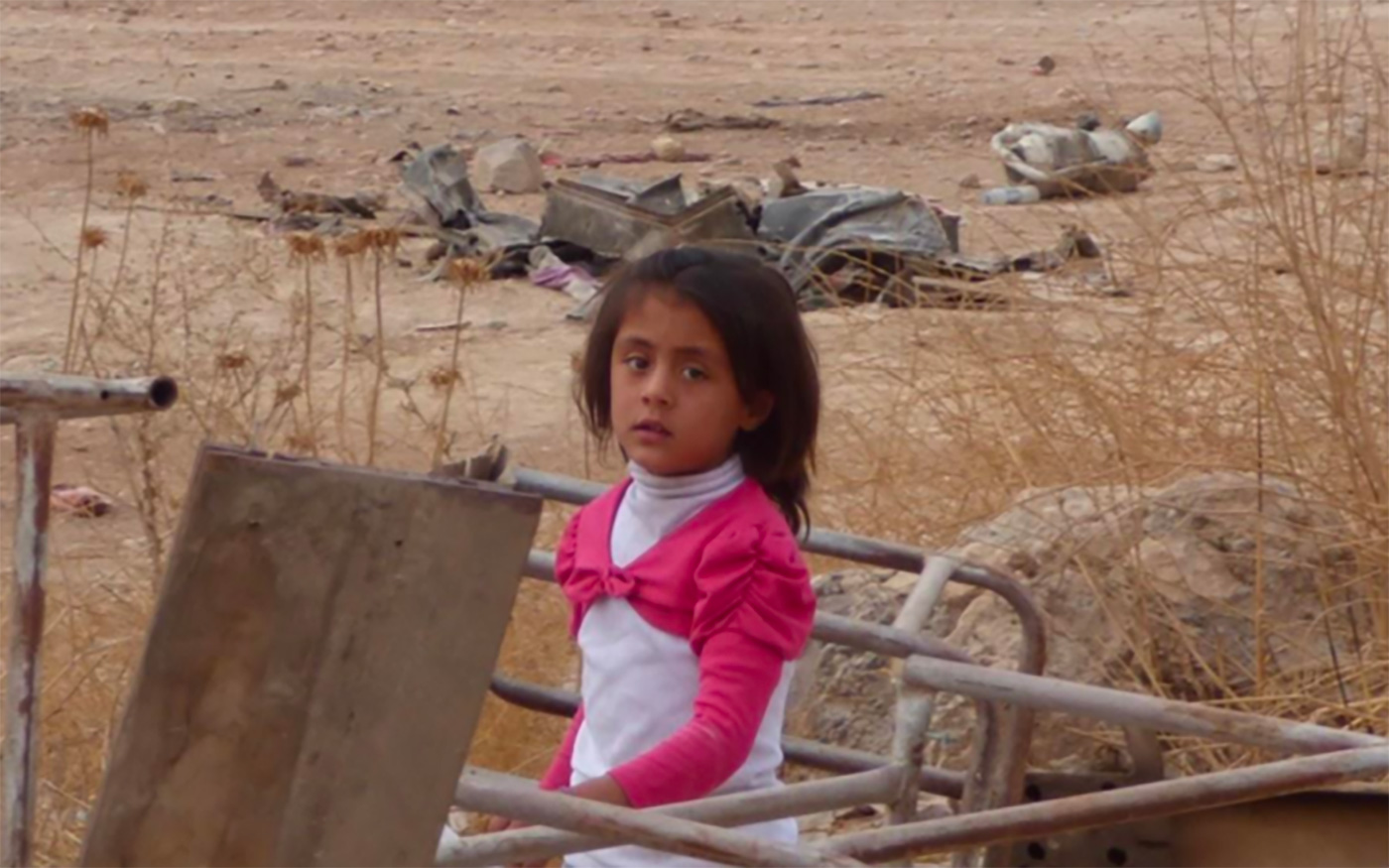On March 30 of this year, longtime anarchist journalist Paul Z. Simons died in Asunción, Paraguay, from apparent heart failure.
As noted in an obituary on AnarchistNews.org, his legacy includes work as editor of Modern Slavery, a journal dedicated to abolishing all forms of enslavement; essays collected on The Anarchist Library that cover everything from English history to recent street protests in Brazil to the role of play in revolution; and his involvement in the New York City squatters’ movement of the 1980s, some of which is recounted in the zine Black Eye.
I met Simons, for the first and only time, in New York three years ago. He was here to give one of his many presentations on the revolution that had begun in Rojava (the region in the north of Syria under autonomous Kurdish governance) in 2012, and which continues to this day. With his interest piqued by reports that, amid the carnage of the civil war, the Kurds in Rojava were reorganizing society along new lines influenced by anarchism, Simons traveled to Syria in 2015. What he experienced there gave him, in his own words, “the one thing I never thought I would have again, which is hope.”
I had missed his presentation, but Simons agreed to meet me the following day. We talked for two or three hours at a diner, where he kindly ran me through his slides and fielded my questions as I recorded our discussion. I was interested in writing an article about why and how politically motivated Westerners were traveling to Syria, and Simons was more than obliging.
With the news of Simons’s death, I felt that sharing our conversation was the least I owed him, given his commitment to the revolution and his generosity toward me. Our discussion below, illustrated with the photographs he sent me, has been edited for brevity and clarity.
Note: The acronyms of some organizations are based on their full names in their native languages, which is why they do not align with their English translations.
• • •
AD.— When did you decide to go to Rojava?
PZS.— I wrote a piece for the Internet in January of 2015. Got my hands on everything I could about what was happening in Rojava, read everything I could from [Kurdish nationalist leader] Abdullah Öcalan. I basically came out and said, as an anarchist, this is something I think I can support. It planted a seed, and once that seed was planted, it germinated over time. In May of 2015, I was sitting in my office and doing some writing—I’m an editor of Modern Slavery—and it struck me: If this was August of 1936 and I knew what was happening in [the Spanish Civil War], would I have gone if I had the time and the money? And I realized, yes, I would. So I said, OK, let me see if I can go into Rojava with a little bit of support and background. I started making some contacts through friends who knew Modern Slavery, and I made contact with some folks in the KRG [Kurdish Regional Government, the governing party in Iraqi Kurdistan].
The second piece of it was that I contacted Lions of Rojava, a website that calls to bring foreign fighters over. Their invitation said: If you’re a writer, if you’re a technician, we can definitely help you come along to Rojava as well. They set me up with a guy on Skype, who I never met and who I believe is in Rojava, and he gave me guidance. I flew to Istanbul, told them, “I’m in Istanbul, where do I go from here?” They got back to me and said, “Go to Erbil and make your way to Faysh Khabur,” which is a crossing on the Tigris river between Iraq and Syria.
I found a car, went up [to Faysh Khabur]. When I was in Istanbul, they told me, “The only way you can get across is as a journalist, are you a journalist?” I said, “Well, I work for a journal, I can produce a press pass off the Internet.” They said, “Do that.” So I showed up, showed my American passport, and showed the press pass I’d made.
This press pass was so bogus, it wasn’t even funny. No signature on it, no dates. They bought it, lock, stock, and barrel. When I got to the other side of the Tigris, I introduced myself to the Asayish, which are the internal security forces, and they’re like, “Oh yes, we knew that you were coming across today, there’s a person from the foreign affairs apparatus who’ll be here shortly.” The guy showed up, I went up to a building, was introduced to some people, PYD [Democratic Union Party, backers of the Rojava Revolution] foreign-service folks. They drove me to Amuda, and immediately set me up in a YPG [People’s Protection Units] outpost. The next day I found myself on my way to Kobane [the city that is the administrative center in Rojava].
How would you describe their political beliefs?
I would say libertarian socialist. I guess the other piece of it is, if they’re listening at all to their commanders and some of the people with midlevel responsibilities, they’re also getting a big dose of anti-Marxism.
How so?
I was talking to the guy who’s responsible for HPC [Civilian Defense Force, commune militia] in the canton. We were about an hour into an interview and he said—I hadn’t asked a question—“You gotta understand, in Marxism . . .” and I thought, Oh my god, here we go, this is going to get ugly, now I’m going to have to ask a whole different series of questions. He says, “In Marxism, basically, the revolution eventually produced a dictator in the form of a party or an individual, and it led to nothing but repression and war. That’s why we’re no longer Marxists. We’re going to construct a socialism that has nothing to do with parties or states, and to maintain that we have to make sure militias are present at all times who have differing allegiances.” The whole point is to push power down as much as possible, instead of up. In other words, decreasing the level of responsibility and duty at the top level, and increasing the level of responsibility and duty at the bottom.
The Rojavan revolution is not a class revolution. I didn’t talk to anyone who used the terms “proletariat,” “bourgeoisie,” or “class struggle.” Rather, I saw the kind of post-left view of the social war, where they don’t have a group of people who are fighting another group of people, but instead are fighting an idea, a concept of civilization, and trying to supplant it with their own concept of civilization.
For the longest time in my life—15, 20 years—there was no hope that I would ever see anything like this. And having walked on ground where there is no state, it instills in me the one thing I never thought I would have again, which is hope that this is a potential future for our species. I have that now, and that in and of itself is worth the trip. Every piece of the danger, every piece of the weirdness was worth it just for that simple realization.

This is the best picture that I took, and I should say that I’m no photographer. That is a Russian tank, a Daesh [Arabic for ISIS] tank in the background. You can see that it’s been incapacitated by an explosion. The Rojava militias had no armor-piercing weapons, so the only way that they could disable tanks is by blowing up the backs. So that is literally a guy coming up, shoving dynamite into it, and exploding the dynamite. The tank is disabled and then they have to kill the crew.
I never even saw this little girl. She was in front of school desks. Right behind me was the former Daesh military headquarters in Kobane. It’s a school. They had taken many of these desks out. Some they had burned as a symbol that Western education no longer obtained in Kobane.

This was coming through Qamishli on my way to Amuda. One of the things that struck me was the visual landscape and the atmosphere of revolution—the YPG flags, HPC flags.

This was a roadblock. If a suicide bomber should come up, in theory they would refuse to follow the zigzags and drive as straight as they can to the Asayish checkpoint. That gives the Asayish time to kill the driver. Most other drivers will go slowly, saying, “No shooting!”

This was a mine that went off the previous night on the road on which we were travelling from Amuda to Kobane. Some Daesh sympathizers had come and buried it under the tarmac. It probably exploded inadvertently, because there was no evidence of any damage to anything else. The road was also shelled about two miles behind me taking this photo. We had to get off the road, and we went through a number of villages. One of the villages was flying the Syrian flag and was considered to be sympathetic to Daesh. Going through that was like, “OK, drive as fast as you can!”

This was Daesh graffiti that had been crossed out. When Daesh come into a village like this, evidently they post messages like, “To the infidel: Convert, leave, or die.”

This was going into Kobane. This berm [a raised barrier], with tank traps, runs all the way to the Turkish border, and then all the way on the other side of Kobane there’s another berm that runs all the way to the border. The Kurds were serious about not having to fight for Kobane twice.
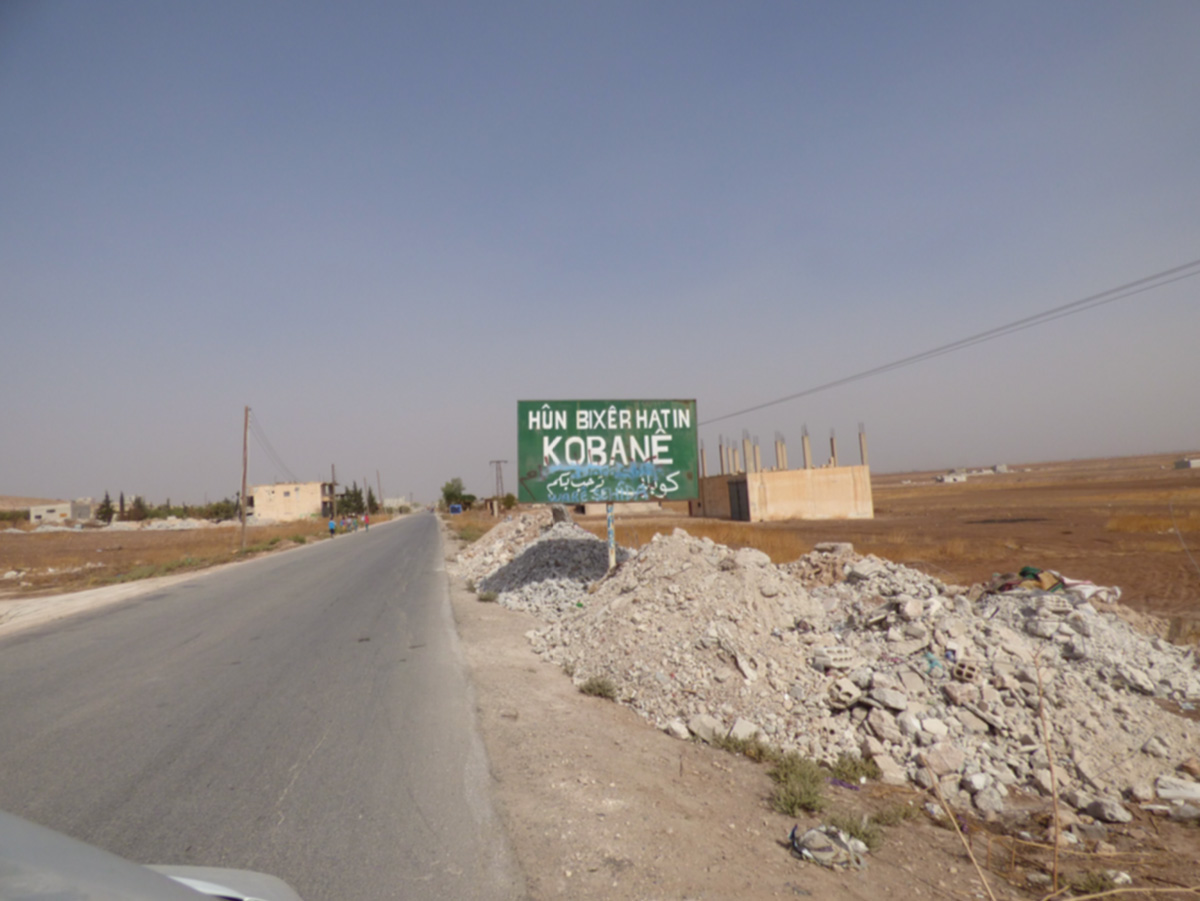
Welcome to Kobane.

This was the beginning of the rebuilding of Kobane: Trucks brought the rubble out to be thrown on the side of the road, then they would go back in. This went on 24 hours a day.

Kobane . . . I don’t think that needs too much comment.





These were Russian-made tanks that were seized [by Daesh] when they got their hands on Syrian stockpiles of weapons.

Your tax dollars at work. This was a Humvee that was taken from Iraq, seized from Iraqis probably around Mosul, and turned into a Daesh vehicle, and then disabled and destroyed by YPG.

This is just a detail from one of the rooms—every hole is a bullet hole, even in the back of the building—showing how fierce the fighting was in Kobane.

This is a commune meeting. What’s interesting about this photo is the women sitting with the men.

This is the only humorous picture I have. This is the old Daesh headquarters. Those are a YPG and YPJ [Women’s Protection Units, all-women PYD militia] flag. I talked to the commander there, who was a very interesting guy with a great sense of humor. I said, “What’s the story with this?” He said, “Well, we’re kind of thinking the previous owner’s not coming back, so we thought we’d redecorate.”

This is a YPG outpost right next to the Turkish border. This kind of gives a feel for the age of the troops, as well as what they’re up against. Those are gunshots in the walls. Every once in a while, they’ll exchange fire with the Turks across the border.
As an anarchist, if you want to identify the enemy, it’s the Turkish government. The Turks helped Daesh infiltrate Kobane, and the Turks have allowed their Syrian refugee camps to become recruitment and training areas for Daesh.

This is an Asayish. The Asayish are the internal security forces. They’re the ones who run the checkpoints. They’re kind of the police force, but they don’t do what the police do. They don’t patrol neighborhoods.

This is the YPG, a tough commando unit that was in Qamishli. This guy left of me is the commander. These are guys who were basically waiting to go to the front.
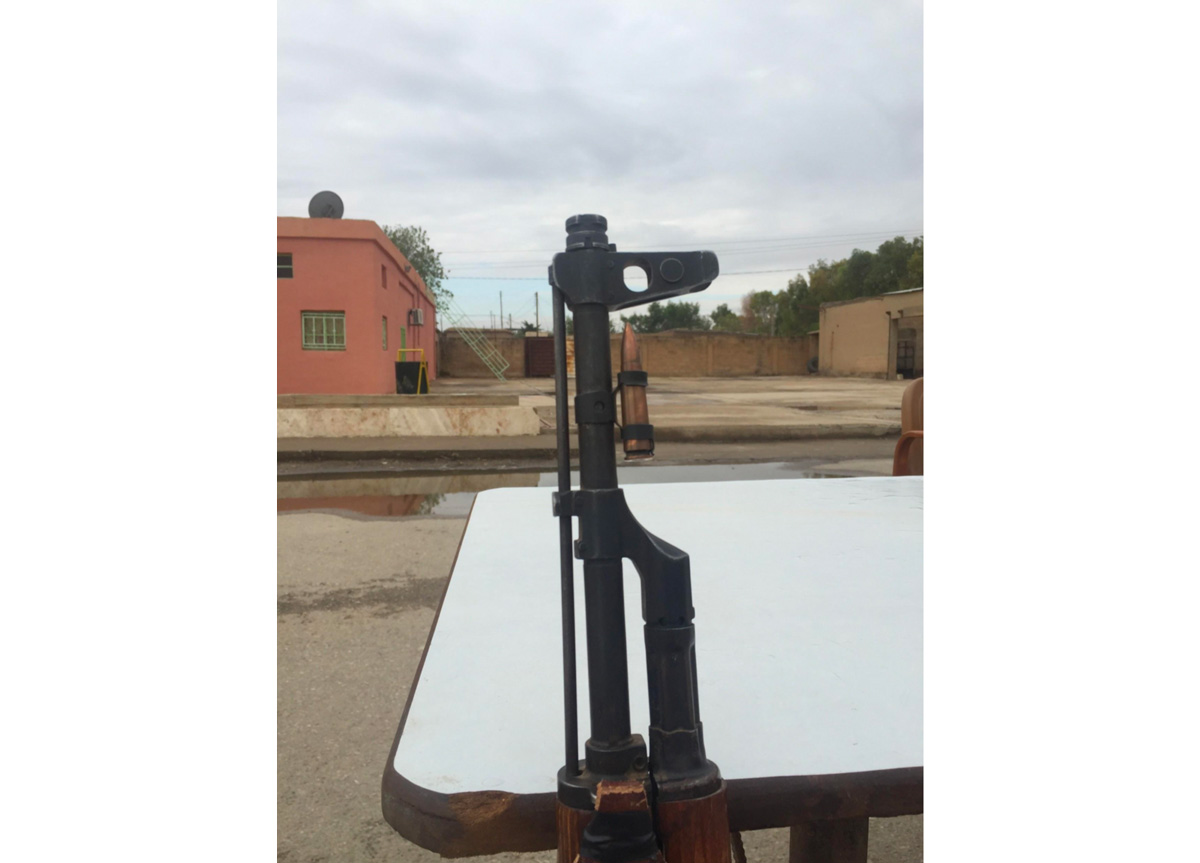
This is not a bullet for this gun, but it reminds the fighter to save one bullet for himself should he be captured.
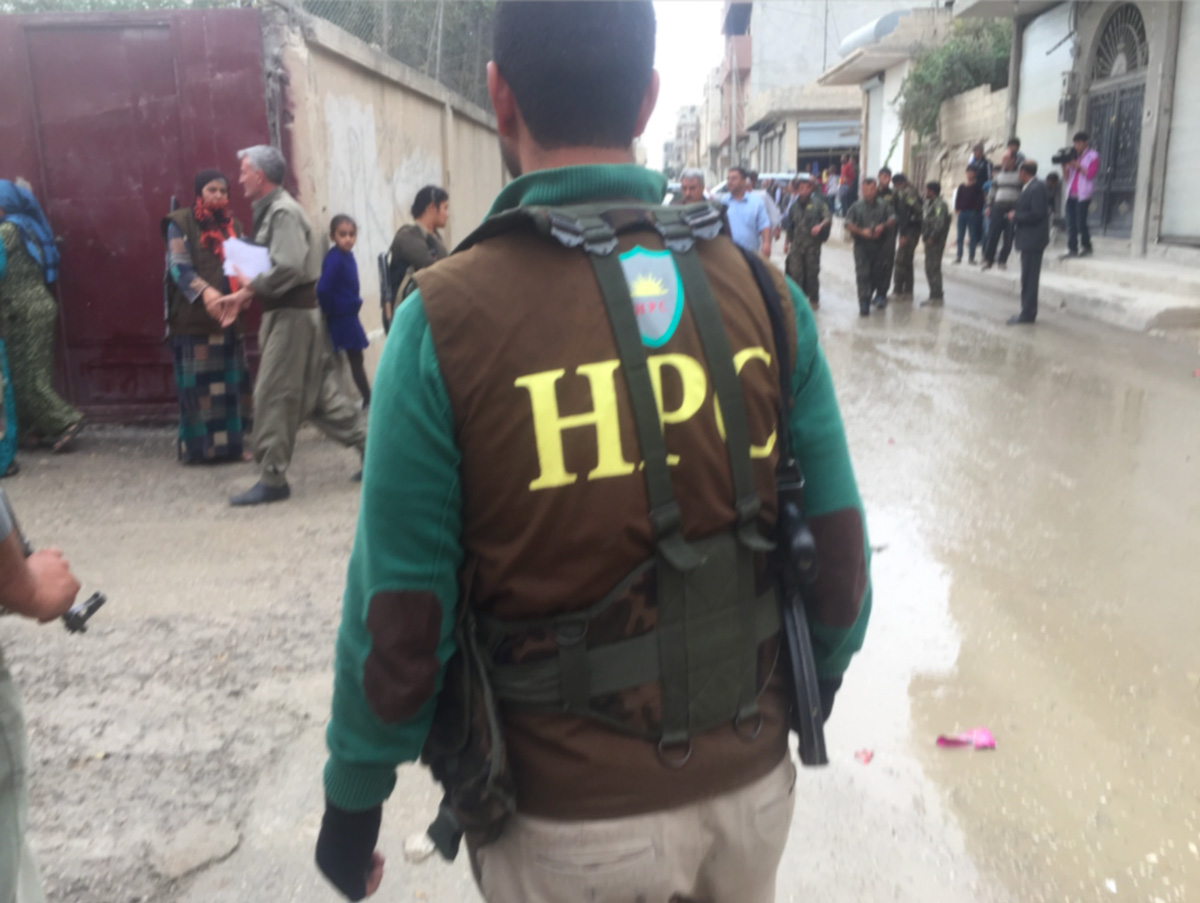
This is the new militia. These militias are tied directly to the council communes, the HPC. Each council commune puts two or three people through this training. It’s about 17 days, they learn to shoot, they get some training on the ideas of Öcalan, that type of thing.

These are all martyrs who were killed during the siege.
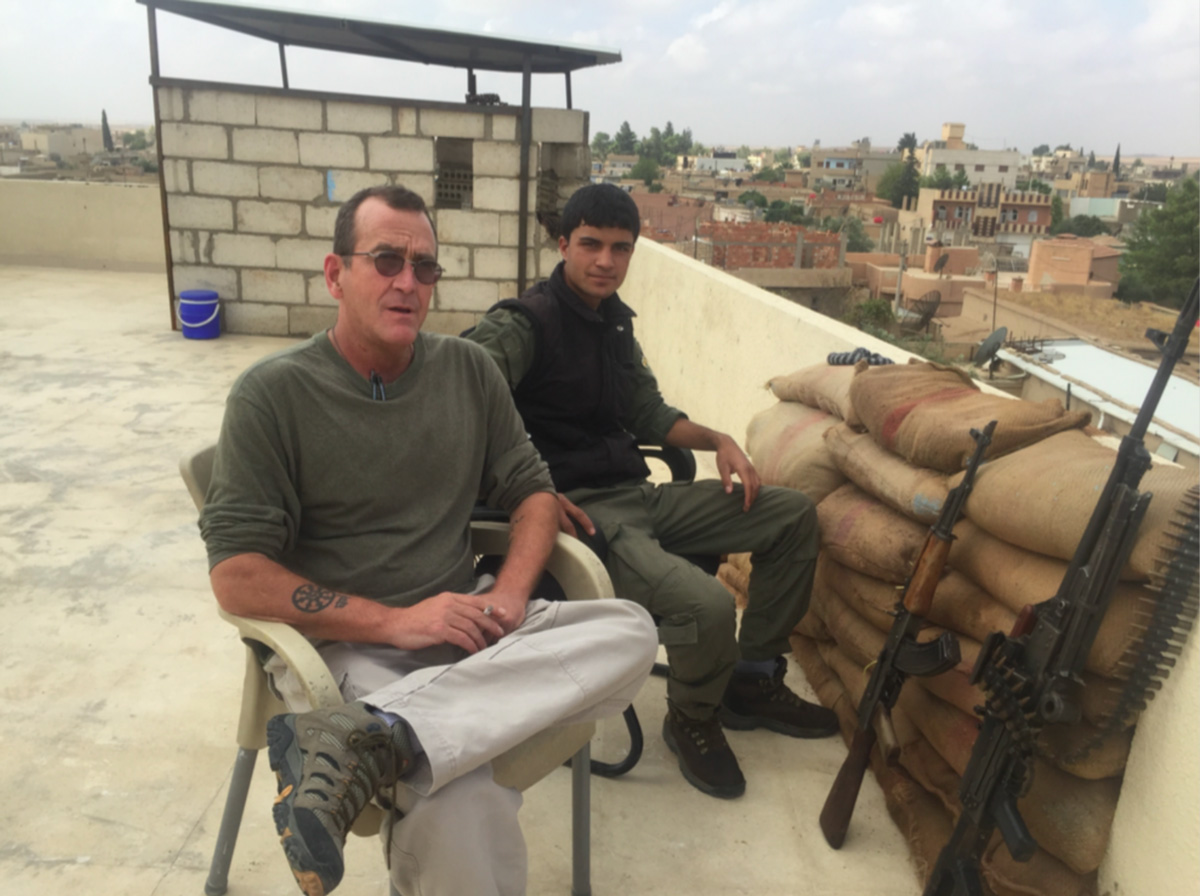
This was Amuda, on the roof of the media center there. I was hanging out with this young Asayish guy. He’s the one who told me, “Never go out without a scarf, because the scarf is good luck against Daesh.” Ever since that day, I don’t. I’m going to be buried in a scarf.
